Buying bonsai can be a lot of fun. Because it can be hard to find good material, when you stumble on something that has potential, it’s easy to get excited.
How do you know when something has potential? For me, the best guide is the trunk.
When we buy bonsai, most of what we pay for is the trunk. It’s a lot easier to fix the branches or roots than it is to fix the trunk, so most of the tree’s value is in the trunk.
In many cases, checking the trunk is easier said than done. Some varieties grow very dense, making it hard to see past the foliage.

Dense foliage – dwarf hinoki
Looking closer reveals little. From this vantage, all we can see is that the tree is healthy.
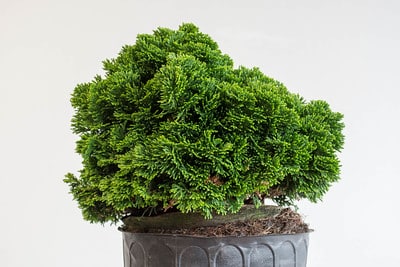
Healthy hinoki foliage
The easiest thing to do to get a better view is to part the foliage and peek inside.
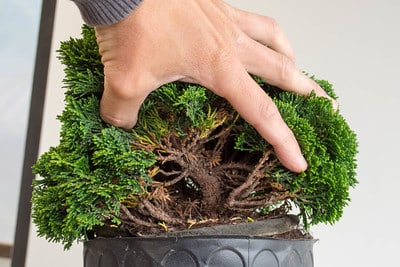
Foliage parted – the trunk is revealed
Here’s where the bit about the surface roots comes into play. Based on what I can see by moving the branches, it appears there is a single trunk of good size and several smaller shoots surrounding it. What I can’t tell is where these surrounding shoots come from. Further investigation is needed.
Ideally, this is the time to scrape away the surface soil and dig down until the base of the trunk flares into the surface roots. If the person selling the tree says it’s OK, see if you can poke around or dig down with your fingers until you find surface roots.
Sometimes the investigative approach won’t be appropriate – other times it will be impossible. If the soil is hard or the root mass is solid, serious effort is required to find the surface roots.
This is fine for less expensive trees. I frequently see buried trunks when shopping for nursery-grown bonsai material and I do what I can to find out what’s going on beneath the surface of the soil, but I don’t let it stop me if I can’t make it all the way down to the surface roots. In these cases, I simply take it under consideration when figuring out how much the tree is worth to me.
As for the present hinoki, I suspected the trunk may be buried as the surface soil was soft and filled with fine roots. I scraped and scraped and scraped, cutting the fine roots as I worked, until I found the surface roots – almost 2 inches down!
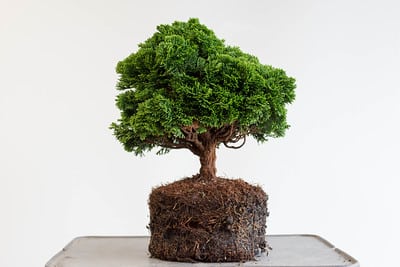
After locating the surface roots
What looked like a possible multi-trunk specimen turned out to be a tree with a single trunk.
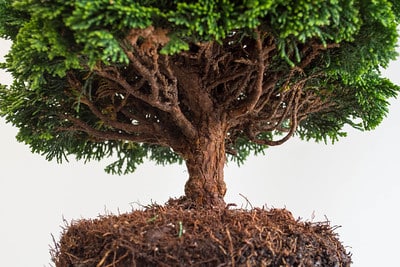
Trunk detail
In this case, I’m happy with what I found below the surface of the soil. The lower part of the trunk has no scars and there are plenty of branches to work with. And if I don’t want the tree to rise straight up from the pot, I can always repot it at an angle.
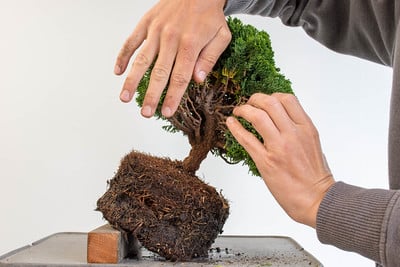
Potential future planting angle
As repotting season is a couple of months away, I dropped the plant back in the container. Now, the next time someone wants a closer look at the roots, they’ll be a lot easier to find.
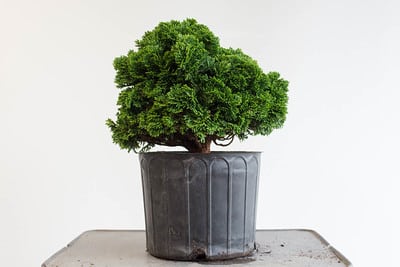
Back in the pot
Countdown to the U.S. National Exhibit: 35 days
The U.S. National Bonsai Exhibition in Rochester, New York, is just over a month away. I’m excited for the event as it’s the biggest and best U.S. bonsai exhibit of the year and a great opportunity to catch up with friends from around the world.
I’ll have trees, tools, pots, books and supplies available at the event, including some of the pines I’ve been developing. I’m assembling trees for the exhibit now and making the final decisions about what to bring. Here’s an example of one of the more developed trees that might be available.
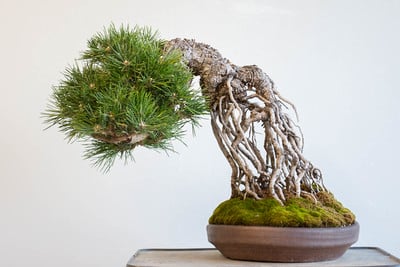
Exposed root black pine – Reiho pot
More updates coming soon!
Subscribe to Bonsai Tonight
New Posts Delivered Every Tuesday and Friday
Richard Dorfman says
Plan to be at the event both days. Will stop by to say hello and personally thank you for maintaining this wonderful, educational blog.
Can you offer any idea what price the exposed root pine might be set at?
Jonas Dupuich says
Thanks Richard – looking forward to meeting you. I have yet to make final decisions about which trees to take or prices – I expect that will happen right before the event.